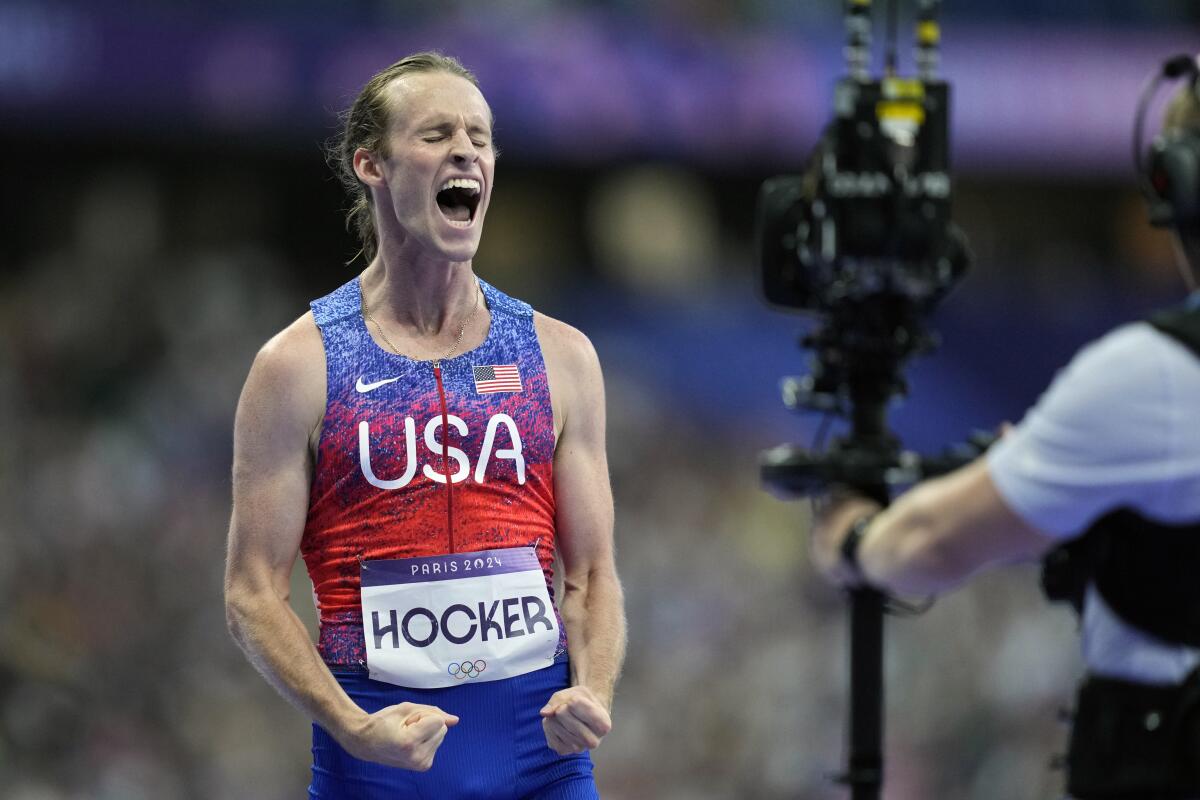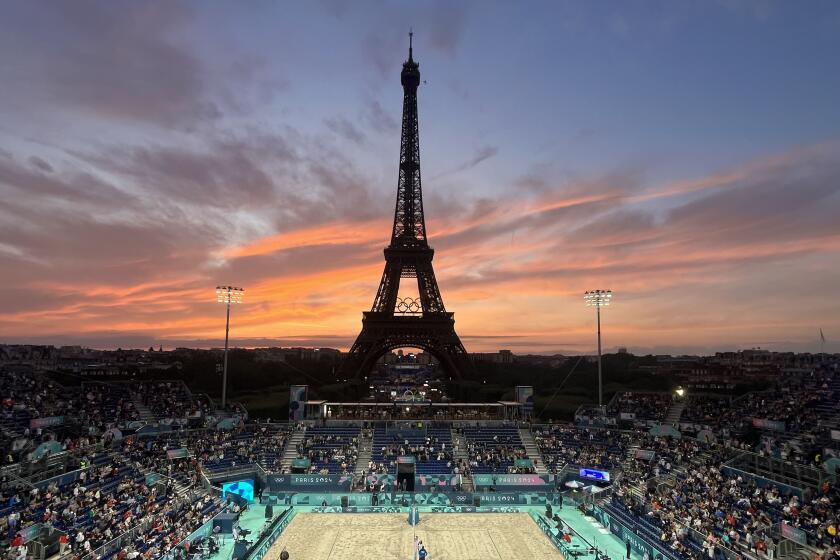Grand Slam Track will look to ‘elevate the sport’ during a non-Olympic year

To hear Michael Johnson tell it, track is the greatest sport you don’t yet know you love.
That’s “track” without the “field,” by the way, for reasons we’ll get to in a bit. Because for now, Johnson, a 16-time world and Olympic sprint champion and nine-time world record-holder, is focusing on the half of the sport he knows best.
And it needs help.
“There’s been a big void in the marketing of track and the profile of track over the last several decades,” he said. “It’s popular at a very high level every four years during the Olympics, then falls out significantly in between. So the vision is to elevate the sport to this sort of level of UFC, Formula One and tennis and golf and other individual sports.
“Now just seems like the right time to do it.”
New head of L.A. Olympics organizing committee Reynold Hoover draws on his planning experience as top military officer during the Afghanistan war.
Johnson believes Grand Slam Track, a series of four three-day meets in which 48 of the fastest men and women in the world race for $12.6 million in prize money, seems like the right way to do it. The series, which was unveiled this week, is modeled after tennis’ four grand slam events and will open in Kingston, Jamaica, in early April. It will also include stops in Miami (May 2-4), Philadelphia (May 30-June 1) and Los Angeles (June 27-29), where it will be headquartered.
The focus will be on head-to-head competition and not times, so there will be no rabbits or pacing lights. Each athlete is required to run in one of six groups — short sprints, long sprints, short hurdles, long hurdles, short distance, long distance — in races ranging from 100 to 5,000 meters. Athletes will compete in two events in each three-day competition and must run in all four meets, with the top performer in each group winning $100,000 each Slam. Eighth place is worth $10,000.
Among the athletes who have already committed to the tour are four-time Olympic champion Sydney McLaughlin-Levrone, 1,500-meter gold medalist Cole Hocker, two-event bronze medalist Grant Fisher, Brazil’s Alison dos Santos, a world champion in the 400-meter hurdles, and Olympic champions Quincy Hall (400 meters), Marileidy Paulino (women’s 400 meters) and Masai Russell (women’s 100-meter hurdles).
“What you’re witnessing right now is the greatest collection of personalities we’ve seen in the sport in quite some time,” said Johnson, 57, who has spent the past 22 years working as a TV commentator for the BBC. “You think about the [Usain] Bolt era and it was only him. Now we have multiple amazing personalities.”

But between Olympic Games, those personalities become nearly invisible, and that leaves the sport racing to rebuild interest among casual fans every four years.
“What’s critical today is storytelling. Fans want to connect with athletes,” Johnson said. “They want to understand the athletes’ journey. They want to understand how that athlete got here and what their struggles were. They want to understand just who that person is.
“That is absolutely built into our league and built into our relationship with our athletes.”
It’s also why Grand Slam Track has no field events, a decision that robs the circuit of some of the sport’s most interesting athletes, among them shot putter Ryan Crouser and pole vaulter Armand Duplantis. The problem, Johnson said, is field events consist of multiple attempts of a given throw or jump, with the winner determined after each competitor has exhausted all their tries. That’s not nearly as dramatic as the mano a mano competition on the track, where some races are over in 10 seconds, the winner decided by an eyelash.
“One of the problems we’ve had with the sport and one of the reasons why the sport doesn’t break through outside the Olympics is because we’re trying to fit the Olympics into one day,” Johnson said. “That may have worked back in the ‘60s and ‘70s, but it no longer works. Fewer and fewer fans actually have the ability to consume and understand the nuances of four different types of jumps, four different types of throws and then sprinting and long-distance running.
Still $1 billion short of their sponsorship goal, L.A. 2028 Olympic organizers are turning to Nike’s former leader of global marketing.
“A single narrative is critical today. So being able to storytell around a singular narrative of the fastest athletes in the world is what we’re focused on because that’s the battle that we feel like we can win.”
That’s a marked change in strategy from the one legendary promoter Al Franken used to pack the Sports Arena for his Sunkist indoor meets into the early 2000s, when track (and field) was a major feature of Southern California’s sports landscape. Franken, who died three years ago, put on meets that had a three-ring-circus feel, with dozens of events featuring high school athletes and Olympic champions.
The action was so fast and varied, you could blink and miss a world record. Which is why Franken’s son Don, who helped his father promote his events, is having trouble embracing the Grand Slam series, where eight races will be run in roughly three hours on each meet day.
“Too much damn dead time,” he said. “There’s been always something going and it keeps track and field exciting. That’s not what’s hurting the sport. What’s hurting the sport is making sure track meets don’t last all day, that they’re faster-paced, they’re quick, exciting. And then integrating music, videos.
“Just bring it into the modern age. We have the greatest damn sport.”
Franken said the sport also needs more promotion, beginning at the college level; more deep-pocketed sponsors willing to pay larger prize-money purses; and more creative thinking, which is why he welcomes Johnson’s ideas, if not the execution.
“Nobody has a clue how to promote the sport,” he said. “It doesn’t take a brain surgeon to do it. It just takes getting down in the trenches and fighting for it and loving this sport.
“Let’s try new things. Let’s do fresh things. I’m all for what Michael Johnson is doing. All of these will contribute because it’s going to get money in the sport, it’s going to put new eyeballs on the sport, it’s going to get new fans.”
Not surprisingly, many of the athletes Johnson has recruited to his new circuit agree.
“Michael’s vision is clear,” said McLaughlin-Levrone, a world record-holder and the first athlete to sign on to Johnson’s program. “He’s exactly the leader the sport needs to break new ground. This is the step forward that track needs to take it to another level.”
Fisher, third in both the 5,000 and 10,000 meters in the Paris Olympics, called Grand Slam Track “the future of the sport.”
The idea has already run into some headwinds, though, precisely because of the marketing failures and narrow thinking the series was created to address. Johnson had considered taking his series to London or Birmingham, England, this year but ultimately chose to stay in the U.S. and Caribbean, a decision to which UK Athletics, the governing body for track and field in the United Kingdom, did not object.
Everything you need to know about the 2024 Paris Summer Olympic Games from the Los Angeles Times’ team of reporters and photographers.
The Guardian reported this week that UK Athletics lost more than $1 million in one day when it hosted a Diamond League event in Birmingham in 2022 and an additional $636,000 on the World Indoor tour in 2023. With the Diamond League returning to London in July, UKA chief executive Jack Buckner told the newspaper that adding another meet just like Johnson’s would have been risky — even as they applauded the Grand Prix concept.
“We’re positive about Michael Johnson’s format,” Buckner said. “They did approach us and we had a really good discussion.
“But,” he added, “if you don’t get an event right and you don’t budget for it properly, it can lose a lot of money quickly.”
If Johnson’s hunch is right, Grand Slam Track might prove to be the way athletes and promoters begin bringing that money — and the fans — back.
More to Read
Go beyond the scoreboard
Get the latest on L.A.'s teams in the daily Sports Report newsletter.
You may occasionally receive promotional content from the Los Angeles Times.








